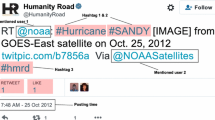Abstract
In this paper, we propose and apply a method to analyze the activeness of an event based on related tweets. The method characterizes and measures activeness of an event by a set of indicators. The indicators proposed in this paper are original tweet count, retweet count, follower count, positive sentiment, negative sentiment, daily change in users count, and sparseness of user community. We present procedures to compute the last two indicators. All indicators collectively are used to determine the activeness of an event. This approach is used to analyze the Syrian-refugee-crisis-related tweets. Its generality is demonstrated by applying it to analyze “immigration”-related tweets.





























Similar content being viewed by others
References
Ahmed K, Tazi NE, Hossny AH (2015) Sentiment analysis over social networks: an overview. In: 2015 IEEE international conference on systems, man, and cybernetics, pp 2174–2179
Bakliwa A et al (2013) Sentiment analysis of political tweets: towards an accurate classifier. In: Proceedings of the workshop on language in social media (LASM 2013), Atlanta, Georgia, June 13 2013, pp 49–58
Batrinca B, Treleaven PC (2015) Social media analytics: a survey of techniques, tools and platforms. AI Soc 30:89–116
Berti B (2015) The syrian refugee crisis: regional and human security implications. Strateg Assess 17(4):41–53
Blitz B (2017) Another story: what public opinion data tell us about refugee and humanitarian policy. J Migr Hum Secur 5(2):379–400
Bollen KA (1984) Multiple indicators: internal consistency or no necessary relationship? Quality Quant 18(1984):377–385
Cárdenas JP, Vidal G, Urbina C, Olivares G, Rodrigo P, Fuentes M (2018) Social crises: signatures of complexity in a fast-growing economy. Complexity. https://doi.org/10.1155/2018/9343451
Coletto M, Esuli A, Lucchese C, Muntean CI, Nardini FM, Perego R, Renso C (2016) Sentiment-enhanced multidimensional analysis of online social networks: Perception of the mediterranean refugees crisis. In: En 2016 IEEE/ACM international conference on advances in social networks analysis and mining (ASONAM), 2016, pp 1270–1277
Cronbach LJ (1951) Coefficient alpha and the internal structure of tests. Psychometrika 16:297–334
Guille A, Hacid H, Favre C, Zighed DA (2013) Information diffusion in online social networks: a survey. SIGMOD Rec 42(2):17–28
Güntner A, Krol MS, De Araújo JC, Bronstert A (2004) Simple water balance modelling of surface reservoir systems in a large data-scarce semiarid region. Hydrol Sci J 49(5):901–918
Jacobson AL, Lalu NM (1974) An empirical and algebraic analysis of alternative techniques for measuring unobserved variables. In: Blalock HM (ed) Measurement in the social sciences. Aldine, Chicago, pp 215–241
Li M, Wang X, Gao K, Zhang S (2017) A survey on information diffusion in online social networks: models and methods. Information 8(4):118. https://doi.org/10.3390/info8040118
Lotan G, Graeff E, Ananny M, Gaffney D, Pearce I, Boyd D (2011) The revolutions were tweeted: information flows during the 2011 Tunisian and Egyptian revolutions. Int J Commun 5:1375–1405
Nerghes A, Lee JS (2018) The refugee/migrant crisis dichotomy on Twitter: a network and sentiment perspective. In: WebSci’18, May 27–30, 2018, Amsterdam, Netherlands, pp 271–280
Newman MEJ (2006) Modularity and community structure in networks. PNAS 103(23):8577–8582
Newman MEJ, Girvan M (2004) Finding and evaluating community structure in networks. Phys Rev E 69:026113
O’Callaghan et al (2014) Online social media in the Syria conflict: encompassing the extremes and the in-betweens. In: IEEE/ACM international conference on advances in social networks analysis and mining (ASONAM 2014)
O’Connor B, Balasubramanyan R, Routledge BR, Smith NA (2010) From tweets to polls: linking text sentiment to public opinion time series. In: Association for the advancement of artificial intelligence, pp 122–129
Öztürk N, Ayvaz S (2018) Sentiment analysis on Twitter: a text mining approach to the Syrian refugee crisis. Telemat Inform 23:136–147
Pope D, Griffith J (2016) An analysis of online Twitter sentiment surrounding the european refugee crisis. In: Proceedings of the 8th international joint conference on knowledge discovery, knowledge engineering and knowledge management (IC3 K 2016)—Volume 1: KDIR, pp 299–306
Ribeiro FN, Araújo MA, Gonçalves P, Gonçalves MA, Benevenuto F (2016) SentiBench—a benchmark comparison of state-of-the practice sentiment analysis methods. EPJ Data Sci 5:23
Smith SR, Aber JL (2018) Increasing understanding for syrian refugee children with empirical evidence. In: Vulnerable children and youth studies, Volume 13, 2018—Issue 1: Special Section: Increasing Understanding for Syrian Refugee Children with Empirical Evidence, pp 1–6
Song M, Kim MC (2013) RT2M : Real-time Twitter trend mining system. In: 2013 International conference on social intelligence and technology, pp 64–71
Stieglitz S, Dang-Xuan L, Bruns A, Neuberger C (2014) Social media analytics an interdisciplinary approach and its implications for information systems. Bus Inf Syst Eng 6(2):89–96
Theodori GL (2003) The community activeness—consciousness matrix. J Ext 41(5). https://www.joe.org/joe/2003october/tt2.php
Yang J, Leskovec J (2010) Modeling information diffusion in implicit networks. In: IEEE international conference on data mining, pp 599–608
Yin B, Yang Y, Liu W (2014) Exploring social activeness and dynamic interest in community-based recommender system. In: International World Wide Web conference (IW3C2), April 7–11, 2014, pp 771–776
Acknowledgements
Karsten Ladner was supported by NSF REU site grant.
Author information
Authors and Affiliations
Corresponding author
Additional information
Publisher's Note
Springer Nature remains neutral with regard to jurisdictional claims in published maps and institutional affiliations.
Appendix
Appendix
In this appendix, we provide the results of our analysis based on data collected during May 31 through July 16, 2018. Due to system problems, data were not available on some days. So we were unable to perform daily analysis reliably. The summary of results is provided. Figure 30 compares the tweet sentiments from different countries on three different random days. It can be seen that USA dominates on all 3 days. As we considered only English tweets, countries from the Middle East appear in yellow region.
Figure 31 shows the tweets originating from countries where English is spoken. As can be seen, most tweets originate from the USA. Figure 32 shows the states from where the tweets are originating.
Rights and permissions
About this article
Cite this article
Ladner, K., Ramineni, R. & George, K.M. Activeness of Syrian refugee crisis: an analysis of tweets. Soc. Netw. Anal. Min. 9, 61 (2019). https://doi.org/10.1007/s13278-019-0606-6
Received:
Revised:
Accepted:
Published:
DOI: https://doi.org/10.1007/s13278-019-0606-6







